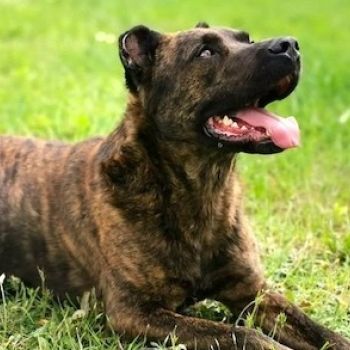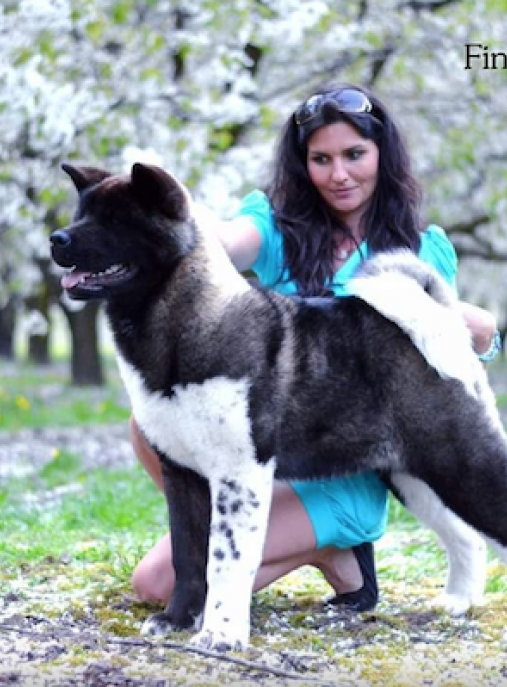The Saint Miguel Cattle Dog, also known as the Cão de Fila de São Miguel, is a remarkable and distinctive breed that hails from the Azores, a group of Portuguese islands in the Atlantic Ocean. This breed is highly regarded for its exceptional herding abilities, loyalty, and protective nature. With a rich history and unique characteristics, the Saint Miguel Cattle Dog has become a beloved breed among dog enthusiasts worldwide.
The history of the Saint Miguel Cattle Dog dates back several centuries. It is believed that these dogs were brought to the Azores by the Portuguese during the colonization of the islands. They were primarily used as working dogs, specifically for herding and guarding cattle. The breed's name, "Cão de Fila," translates to "dog with a queue," referring to their docked tails, which were traditionally done to prevent injuries during herding.
According to the FCI (Fédération Cynologique Internationale) typology, the Saint Miguel Cattle Dog belongs to Group 2, Section 2.2, which includes Molossoid breeds. These breeds are known for their muscular build, strong jaws, and protective instincts. The Saint Miguel Cattle Dog is classified as a Molossoid type, indicating its physical and behavioral characteristics align with this group.
The Saint Miguel Cattle Dog is a versatile breed that serves various purposes. Primarily, they excel as herding dogs, displaying exceptional skills in controlling and moving livestock. Their natural instincts and intelligence make them adept at managing cattle, sheep, and other livestock. Additionally, their protective nature makes them excellent guard dogs, ensuring the safety of their family and property.
In terms of physical attributes, the Saint Miguel Cattle Dog is a medium to large-sized breed. Males typically stand between 22 to 26 inches (56 to 66 cm) at the shoulder, while females are slightly smaller, ranging from 20 to 24 inches (51 to 61 cm). The breed's weight varies between 66 to 99 pounds (30 to 45 kg), with males generally being heavier than females.
The Saint Miguel Cattle Dog possesses a robust and muscular build, reflecting its working heritage. Their strong, well-developed limbs enable them to navigate challenging terrains and perform their herding duties effectively. Their coat is short, dense, and weather-resistant, providing protection against the harsh elements of the Azores. The breed's coat color is predominantly fawn or wolf gray, often with white markings on the chest and feet.
One of the most notable characteristics of the Saint Miguel Cattle Dog is its loyalty and devotion to its family. They form strong bonds with their owners and are known to be highly protective. This breed is naturally suspicious of strangers, making them excellent guard dogs. However, early socialization and proper training are crucial to ensure they remain well-mannered and balanced.
The Saint Miguel Cattle Dog has a life expectancy of around 10 to 12 years. Like many large breeds, they may be prone to certain health issues, including hip dysplasia, elbow dysplasia, and bloat. Regular exercise, a balanced diet, and routine veterinary care are essential to maintain their overall health and well-being.
In addition to their working abilities, the Saint Miguel Cattle Dog possesses a calm and gentle temperament, making them suitable companions for experienced dog owners. They thrive in an environment where they have a job to do and receive ample mental and physical stimulation. This breed requires regular exercise to prevent boredom and destructive behaviors.
In conclusion, the Saint Miguel Cattle Dog is a remarkable breed with a rich history and exceptional working abilities. Their herding skills, loyalty, and protective nature make them invaluable assets to farmers and families alike. With their distinctive appearance and devoted temperament, these dogs have rightfully earned their place as beloved companions and working partners.
The Saint Miguel Cattle Dog, also known as the Cão de Fila de São Miguel, is a remarkable breed with a unique character. These dogs originate from the Azores, a group of Portuguese islands in the Atlantic Ocean. They were primarily bred for herding cattle and guarding properties, which has shaped their distinct personality traits.
In terms of appearance, the Saint Miguel Cattle Dog is a medium to large-sized breed, with a strong and muscular build. They have a broad head, a powerful jaw, and expressive eyes that reflect their intelligence and alertness. Their coat is short, dense, and typically comes in shades of fawn, brindle, or black.
When it comes to their character, Saint Miguel Cattle Dogs are known for their loyalty, courage, and protective nature. They are deeply devoted to their families and will go to great lengths to protect them. This breed is highly alert and vigilant, making them excellent watchdogs. They are naturally suspicious of strangers and will not hesitate to bark or act defensively if they perceive a threat.
While Saint Miguel Cattle Dogs are incredibly loyal, they can also be independent and strong-willed. This breed requires an experienced and confident owner who can establish themselves as the pack leader. Early socialization and consistent training are crucial to ensure they grow into well-rounded and obedient dogs.
Training a Saint Miguel Cattle Dog requires patience, firmness, and positive reinforcement techniques. These dogs are intelligent and eager to please, but they can be stubborn at times. It is important to establish clear boundaries and provide consistent training from an early age. Early exposure to various environments, people, and other animals is essential to prevent them from becoming overly protective or aggressive.
Exercise is another key aspect of raising a Saint Miguel Cattle Dog. These dogs have a high energy level and require regular physical and mental stimulation. Daily walks, playtime, and engaging activities such as obedience training or agility courses are essential to keep them happy and prevent boredom-related behaviors.
Despite their protective nature, Saint Miguel Cattle Dogs can be gentle and affectionate with their families. They are known to form strong bonds with their owners and are excellent with children when properly socialized. However, due to their strong guarding instincts, they may not be suitable for households with small pets or other dominant dogs.
In conclusion, the Saint Miguel Cattle Dog is a breed with a distinct character. Their loyalty, courage, and protective nature make them excellent guardians and companions. However, they require experienced owners who can provide consistent training, socialization, and plenty of exercise. With the right care and guidance, these dogs can thrive and bring immense joy to their families.
The Saint Miguel Cattle Dog, also known as the Cão de Fila de São Miguel, is a robust and loyal breed originating from the Azores, Portugal. These dogs were traditionally used for herding cattle and guarding properties, making them highly intelligent, protective, and adaptable. If you are considering bringing a Saint Miguel Cattle Dog into your home, it is essential to understand their specific care needs to ensure their well-being and happiness. Here are some tips on how to care for dogs of this breed:
1. Exercise: Saint Miguel Cattle Dogs are energetic and require regular exercise to maintain their physical and mental health. Daily walks, playtime, and engaging activities such as obedience training or agility courses are highly recommended. Providing them with a secure and spacious yard to roam and explore is also beneficial.
2. Mental Stimulation: These dogs are intelligent and thrive on mental stimulation. Engage them in puzzle toys, obedience training, and interactive games to keep their minds sharp. Failure to provide mental stimulation can lead to boredom and destructive behavior.
3. Socialization: Early and ongoing socialization is crucial for Saint Miguel Cattle Dogs. Introduce them to various people, animals, and environments from a young age to ensure they grow up to be well-rounded and friendly dogs. Proper socialization helps prevent aggression and fear-based behaviors.
4. Training: These dogs are highly trainable but require consistent and firm leadership. Use positive reinforcement techniques such as treats, praise, and rewards to motivate them during training sessions. Avoid harsh training methods or punishment, as it can lead to fear or aggression.
5. Grooming: Saint Miguel Cattle Dogs have a short, dense coat that requires minimal grooming. Regular brushing with a firm bristle brush will help remove loose hair and keep their coat healthy. Bathing should be done as needed, typically every few months, to maintain cleanliness. Additionally, regular dental care, nail trimming, and ear cleaning are essential parts of their grooming routine.
6. Health Care: Like any other breed, Saint Miguel Cattle Dogs require routine veterinary care. Ensure they receive vaccinations, regular check-ups, and preventive treatments for fleas, ticks, and heartworms. Regular exercise, a balanced diet, and maintaining a healthy weight are also crucial for their overall well-being.
7. Proper Diet: Feed your Saint Miguel Cattle Dog a high-quality, balanced diet that suits their age, size, and activity level. Consult with your veterinarian to determine the appropriate portion sizes and feeding schedule. Avoid overfeeding, as these dogs can be prone to weight gain, which can lead to joint problems.
8. Avoid Overexertion: While these dogs are known for their endurance, it is important to avoid overexertion, especially in hot weather. Provide them with ample shade, fresh water, and rest breaks during physical activities to prevent heatstroke or exhaustion.
9. Secure Fencing: Saint Miguel Cattle Dogs have a strong prey drive and protective instincts. Ensure your yard is securely fenced to prevent them from escaping and potentially causing harm to themselves or others. Regularly check for any gaps or weaknesses in the fence.
10. Avoid Isolation: These dogs thrive on human companionship and can develop separation anxiety if left alone for extended periods. Avoid leaving them alone for too long and provide them with mental stimulation, toys, and a comfortable space when you are away.
Remember, owning a Saint Miguel Cattle Dog requires commitment, time, and effort. By providing them with proper care, training, and socialization, you can enjoy a loving and loyal companion for many years to come.
The Saint Miguel Cattle Dog, also known as the Cão de Fila de São Miguel, is a magnificent breed that hails from the Azores, a group of Portuguese islands in the Atlantic Ocean. These dogs are known for their impressive size, strength, and loyalty. When it comes to their color, the Saint Miguel Cattle Dogs typically display a striking and distinctive coat.
The most common color seen in Saint Miguel Cattle Dogs is a rich and deep shade of fawn. This color is often described as a warm, reddish-brown hue that exudes elegance and strength. The fawn coloration is typically uniform throughout the dog's body, creating a harmonious and balanced appearance.
The fawn coat of the Saint Miguel Cattle Dog is often accompanied by darker markings, which add depth and character to their overall appearance. These markings can be seen on various parts of their body, including the face, ears, back, and tail. The darker shades often appear as a black or dark brown color, creating a beautiful contrast against the fawn base.
One of the most distinctive features of the Saint Miguel Cattle Dog's coat is the presence of a black mask. This mask covers the dog's muzzle and extends to the eyes, giving them a striking and intense expression. The black mask not only adds to their aesthetic appeal but also serves as a protective shield, as these dogs were originally bred to work with livestock and needed to protect their faces from potential injuries.
In addition to the fawn and black coloration, some Saint Miguel Cattle Dogs may also exhibit white markings on their chest, paws, or tail tip. These white patches provide a delightful contrast against the fawn coat, further enhancing their overall appearance.
The coat of the Saint Miguel Cattle Dog is typically short and dense, which helps protect them from the harsh weather conditions of the Azores. This low-maintenance coat is easy to groom and requires minimal effort to keep it looking its best.
Overall, the common color of the Saint Miguel Cattle Dog is a stunning fawn, complemented by darker markings and a black mask. This coloration, along with their impressive size and loyal nature, makes them a truly remarkable and eye-catching breed. Whether working alongside farmers or serving as a devoted family companion, the Saint Miguel Cattle Dog's coat color adds to their charm and allure.
The Saint Miguel Cattle Dog, also known as the Cão de Fila de São Miguel, is a robust and hardy breed known for its excellent health. These dogs have a strong immune system and are generally free from many common canine health issues. However, like any other breed, they are still susceptible to certain diseases and require proper care to maintain their overall well-being.
One of the most common health concerns in Saint Miguel Cattle Dogs is hip dysplasia. This is a hereditary condition where the hip joint doesn't develop properly, leading to pain, lameness, and arthritis. Responsible breeders conduct hip evaluations and only breed dogs with good hip scores to minimize the risk of this condition. Regular exercise, a balanced diet, and maintaining a healthy weight can also help reduce the likelihood of hip dysplasia.
Another health issue that can affect these dogs is progressive retinal atrophy (PRA). PRA is a degenerative eye disease that leads to vision loss and, in severe cases, blindness. Regular eye examinations by a veterinary ophthalmologist can help detect PRA early on, allowing for appropriate management and care. Responsible breeders also screen their breeding dogs for PRA to prevent passing on the condition to future generations.
Saint Miguel Cattle Dogs may also be prone to certain skin conditions, such as allergies and dermatitis. These can be caused by environmental factors, food allergies, or parasites. Regular grooming, including brushing their coat and checking for any signs of skin irritation or infection, is essential. A high-quality diet that meets their nutritional needs can also help support healthy skin and coat.
To ensure the overall health of Saint Miguel Cattle Dogs, regular veterinary check-ups are crucial. Vaccinations, parasite prevention, and dental care should be part of their routine healthcare. Dental hygiene is particularly important as these dogs are prone to dental issues like tartar buildup and gum disease. Regular teeth brushing and providing appropriate dental chews can help maintain good oral health.
Exercise is vital for the physical and mental well-being of Saint Miguel Cattle Dogs. They are an active breed that thrives on regular physical activity. Daily walks, playtime, and mental stimulation through training or puzzle toys are necessary to prevent boredom and promote a healthy lifestyle.
Lastly, socialization and mental stimulation are essential for the overall well-being of these dogs. They are known for their loyalty and protective nature, but early socialization with other animals and people is crucial to prevent aggression or fear-based behaviors. Mental stimulation can be achieved through obedience training, interactive toys, and engaging activities that challenge their intelligence.
In conclusion, Saint Miguel Cattle Dogs are generally a healthy breed, but they can still be prone to certain health issues. Responsible breeding practices, regular veterinary care, proper nutrition, exercise, grooming, and socialization are key factors in maintaining their health and well-being. With the right care, these dogs can live long, happy, and healthy lives.
The Saint Miguel Cattle Dog, also known as the Cão de Fila de São Miguel, is a robust and energetic breed originating from the Azores Islands in Portugal. To ensure the optimal health and well-being of these dogs, it is crucial to provide them with a balanced and nutritious diet. This text will provide an extensive description of the nutrition requirements for Saint Miguel Cattle Dog dogs, along with advice on feeding and what to avoid.
The nutritional needs of Saint Miguel Cattle Dog dogs are similar to those of other medium to large-sized breeds. A well-balanced diet should consist of high-quality proteins, healthy fats, carbohydrates, vitamins, and minerals. Proteins are essential for muscle development and repair, while fats provide energy and support the health of the skin and coat. Carbohydrates are a valuable source of energy, and vitamins and minerals are necessary for overall health and proper bodily functions.
When selecting commercial dog food for your Saint Miguel Cattle Dog, opt for high-quality brands that use real meat as the primary ingredient. Look for labels that specify whole meats like chicken, beef, or fish, rather than by-products or meat meals. Avoid foods that contain excessive fillers, artificial preservatives, and additives. It is also important to choose a formula that is appropriate for your dog's age, size, and activity level.
In addition to commercial dog food, it is beneficial to incorporate fresh, whole foods into your Saint Miguel Cattle Dog's diet. Lean meats like chicken, turkey, or beef can be cooked and added to their meals. Fish such as salmon or sardines are excellent sources of omega-3 fatty acids, which promote a healthy coat and skin. Fruits and vegetables like carrots, apples, and green beans can be steamed or pureed and mixed with their food to provide additional vitamins and fiber.
It is crucial to feed your Saint Miguel Cattle Dog the appropriate amount of food to maintain a healthy weight. Obesity can lead to various health issues, including joint problems and heart disease. Follow the feeding guidelines provided by the dog food manufacturer, but also monitor your dog's body condition and adjust the portions accordingly. If your dog becomes overweight, consult with a veterinarian to develop a weight management plan.
While it is important to provide a balanced diet, there are certain foods that should be avoided as they can be toxic or harmful to dogs. Some common foods that should never be fed to Saint Miguel Cattle Dogs include chocolate, caffeine, grapes, raisins, onions, garlic, avocados, and alcohol. These foods can cause digestive upset, organ damage, or even be fatal to dogs. Additionally, bones, especially cooked bones, should never be given to dogs as they can splinter and cause choking or internal injuries.
Lastly, always ensure that your Saint Miguel Cattle Dog has access to fresh, clean water at all times. Hydration is essential for their overall health and well-being.
In conclusion, providing a well-balanced and nutritious diet is crucial for the health and vitality of Saint Miguel Cattle Dog dogs. Choose high-quality commercial dog food, incorporate fresh, whole foods, and avoid toxic or harmful substances. By following these guidelines and consulting with a veterinarian when needed, you can ensure that your Saint Miguel Cattle Dog thrives on a healthy and balanced diet.






